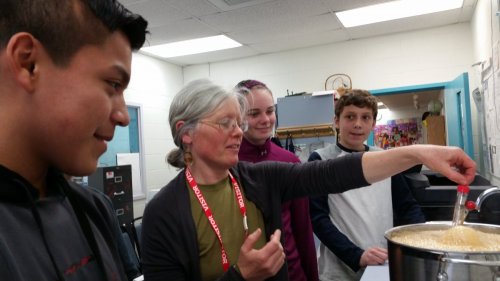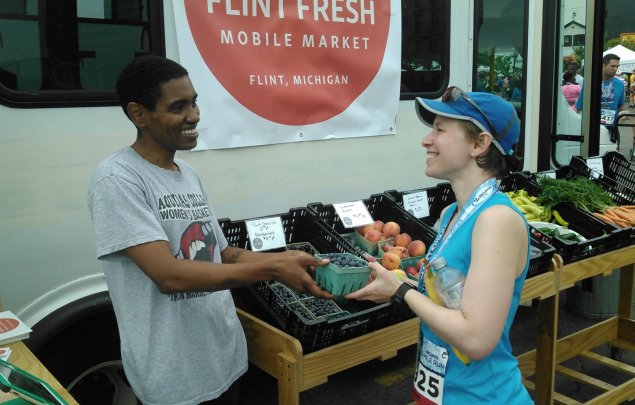Connecting farm viability and community vitality
Takeaways
- Community benefit investments address increasing access to healthy food and supporting healthy behaviors, exemplifying making the healthy choice the easy choice.
- Strategies combine promoting community health, local economic development, and farm viability.
- Healthy Roots Collaborative: In 2016, Healthy Roots reached 3,100 individuals through 16 community events, assisted 28 schools with farm-to-school efforts, and collected 10,600 pounds of fresh, local produce for distribution to food pantries. The collaborative works with 150 farms and food producers.
- RiseVT: Since its launch in 2015, Rise-VT has experienced successes including:
- 56 businesses engaged in worksite wellness efforts.
- 18 school participants; 15 have implemented safe routes to school.
- 11 municipalities have instituted wellness programs and policies to support community changes.
- 3,416 individuals have participated by signing the pledge or completing health assessments and 1,832 individuals have used the online portal, website dashboard, and health coaching.
- Hospital name: Northwestern Medical Center
- Hospital type: Private, nonprofit
- Hospital size: Small (70 beds)
- Geographic area: Urban
- System/Network: Independent
- Network coverage: Northwestern Vermont (Franklin and Grand Isle Counties)
- White, non-Hispanic: 94% (Franklin), 93.3% (Grand Isle)
- Hispanic: 1.6% (Franklin), 2.1% (Grand Isle)
- Black, non-Hispanic: 0.7% (Franklin), 0.6% (Grand Isle)
- Asian/Pacific Islander: 0.7% (Franklin), 0.5% (Grand Isle)
- Other: 3% (Franklin), 3.5% (Grand Isle)
- Community health needs assessment region: Franklin and Grand Isle Counties (predominantly rural area in the northwestern corner of Vermont)
- Population: 55,810
- Obesity (adult): 32% Franklin County, 27%Grand Isle County
- Diabetes: 12% Franklin County, 10.8% Grand Isle County
Like many hospitals across the country, Northwestern Medical Center serves a community struggling with obesity and poor health behaviors. While the hospital’s location is considered urban/metro due to its vicinity to Burlington, the area is largely rural, encompassing Franklin and Grand Isle counties in the northwest corner of Vermont.1 Food insecurity affects more than 10 percent of the population (11 percent in Grand Isle and 12 percent in Franklin), and data indicate an increasing prevalence of obesity in both counties.
Community health needs assessment: Priorities and process
- Food and diet-related disease priorities:
- 2013 CHNA-Obesity
- 2016 CHNA -Obesity
- Participation from food-related organizations in CHNA process:
- Vermont Agency of Human Services, Martha’s Kitchen (regional soup kitchen), Vermont Department of Health
- How/why did obesity (food issues) emerge as a priority:
- A 2012 CHNA community survey identified obesity as a “top resident concern,” and secondary data analysis found rates of morbid obesity exceeded U.S. average by five percent while healthy eating lagged U.S. average by ten percent. In 2016, an online survey of 29 local expert advisors found 72 percent supported retaining obesity as a health priority.
- Key community indicators:
- 32.4 percent of Franklin County population is characterized as BMI-Morbid/Obese, which exceeds national average by 5.8 percent.
- 27.3 percent of Grand Isle population is characterized as BMI-Morbid/Obesity
Full Assessment: Northwestern Medical Center 2016 Community Health Needs Assessment
Assessing health needs — and how to meet them
Community health needs assessment process
Northwestern Medical Center has a long history of working with community partners to address health needs. As part of its organizational structure, the hospital has a board of 150 incorporators, local residents that “serve as a formal connection between the hospital and the community.” These individuals are responsible for electing the hospital’s board of directors and acting as ambassadors and advocates of the hospital. Prior to the federal community health needs assessment (CHNA) requirement, the hospital collaborated with Franklin Grand Isle United Way (now part of the United Way of Northwest Vermont) and Franklin-Grand Isle Community Partnership to determine how to effectively use their collective resources to address community health needs.
Jonathan Billings, vice president of planning and community relations directs Northwestern Medical Center’s community benefit reporting and community health needs assessment process. The hospital’s lifestyle medicine department carries out the community benefit activities focused on primary and secondary prevention efforts. Lifestyle medicine staff members include physicians, nurses, dietitians, diabetes management educators, health coaches, and food system specialists. According to Billings, the CHNA process plays a valuable role in shaping both community benefit initiatives and the hospital’s overall strategic direction, and also functions as a blueprint for community groups who “take it and run with it in their own action plans.”

Investing in solutions
Implementation strategy
Northwestern Medical Center’s leadership recognizes that access to affordable, high quality, nutritious, food is fundamental to good health. The hospital’s strategy to address obesity and diet-related health issues combines community and clinical components with long-term investments focused on increasing access to healthy, local food.
Hospital leadership understands the role of agricultural activity plays in its community’s economic health and how a strong agricultural economy supports its work around food access and healthy eating. Community partners have echoed the importance of farm-to-table as a strategy to address community health needs that would benefit individuals and organizations across Franklin and Grand Isle counties.
The obesity-prevention strategy developed by Northwestern Medical Center connects community engagement, local food system development, and education. The hospital also plays a role in efforts to improve health through policy and systems change. Northwestern Medical Center has actively advocated for a tax on sugar-sweetened beverages as part of its obesity-prevention efforts and is active in the Vermont Blueprint for Health implementation for its region.

— Jonathan Billings, Northwestern Medical Center vice president of planning and community relations
Healthy Roots Collaborative
Healthy Roots Collaborative works “to strengthen the local food system of Northwest Vermont for the health and vitality of [its] community.”
- Program type: Regional food system advocacy
- Program administrator: Northwestern Medical Center’s lifestyle medicine department
- Program founded: 2011, incorporated into Northwestern Medical Center 2015
- Hospital role: Manage or coordinate a program, conduct food, nutrition, and cooking education, provide staff members support for grant writing
- Community partners include: South Hero Land Trust, Franklin County Industrial Development Corp., Northwest Regional Planning Commission, Lake Champlain Islands Agricultural Network, Franklin/Grand Isle Workforce Investment Board
- Population served: Community-wide, with specific programs to support vulnerable populations
- Program goal: To build a strong local agricultural economy and to ensure local residents have access to healthy locally grown food.
- Health needs addressed: Obesity, healthy food access
- Key outcomes: In 2016, Healthy Roots reached 3,100 individuals through 16 community events and worked with 28 schools on farm-to-school programming. The gleaning initiative collected 10,600 pounds of fresh, local produce for distribution to food pantries in 2016 (its first year) and 15,000 pounds in 2017.

Project description
Healthy Roots Collaborative combines healthy food access, food and nutrition education, and local food system development. The initiative emerged from an online farmers market, created in 2011 by a community member who wanted to make it easier for Fairfield, Vermont residents to buy locally produced foods. People placed orders with individual producers and picked up all the products they ordered together, at a designated community location. The coordinator worked out of the community library, and Charlotte Homesteading Group, which ran pop-up markets across Vermont and managed deliveries. Over time, the market’s service area grew to include all of Franklin County and to involve a diverse group of stakeholders with a shared interest in building the local food system.
In 2015, stakeholders formed the Diversified Agricultural Network. This cross-sector network included representatives from the regional planning commission, land trusts, farmers, workforce development interests, and Northwestern Medical Center. Participants’ interests encompassed a range of issues related to the food system, from farm viability and local economic development to increasing healthy food access and improving the public’s health. Hospital leadership viewed engagement in the Diversified Agricultural Network as valuable to advancing its strategy to address obesity and food access and to supporting its existing community wellness initiatives.
The Diversified Agriculture Network created the Healthy Roots Collaborative and secured funding, as part of a Department of Housing and Urban Development (HUD) Sustainable Communities grant to the Northwest Regional Planning Commission, to hire a part-time coordinator to develop programs and activities. Upon completion of the grant, Northwestern Medical Center incorporated the Healthy Roots Collaborative into its operations, with the Diversified Agricultural Network becoming the Healthy Roots Collaborative advisory committee.
Program activities
Healthy Roots Collaborative is a community-wide initiative. Certain program components focus on particular sectors (farms, institutions) while others benefit specific high-needs and high-risk populations. Program activities include:
- Community cold storage space: Healthy Roots manages a facility with a walk-in cooler, walk-in freezer, and dry storage space, which was established after farmers expressed a need for it. The space enables Healthy Roots to support both local food sales and food access because farmers who use the storage are also linked into the hospital’s other programs, such as farm to school.
- Gleaning program: Piloted in 2016, the gleaning program harvests excess fruits and vegetables left in fields (after the primary harvest) for distribution to food pantries. Healthy Roots has a gleaning specialist (on contract) to manage food distribution and volunteers who work with partner farms to gather crops, as needed. Northwestern Medical Center is also involved in the Vermont Gleaning Collective.
- Value chain facilitation/farm viability: Healthy Roots works with institutions, businesses, and local restaurants to build their local purchasing efforts.
- Farm to school: Healthy Roots supports farm-to-school programs by advising school food service on local procurement, holding taste tests for students, arranging field trips, and assisting with school gardens.
- Consumer education: Healthy Roots staff members regularly take part in community-wide events and go to business sites and institutions in the community to conduct taste tests and to share information about healthy, local foods (both what they are and where to find them).
- Online farmers market: The online market ran for nearly six years and connected Healthy Roots to nearly 600 individuals. The market served as an important conduit for connecting with community members but ceased operations in spring of 2017 due to low sales.
While program activities such as nutrition education, clearly align with the hospital’s priorities, others, such as the cold storage, reflect a broad (and connected) community need.
Partnerships and hospital role
The Healthy Roots Collaborative follows a collective impact model, with Northwestern Medical Center functioning as the backbone organization. Community leaders from the Diversified Agricultural Network play an important role in the program, as an advisory committee. While Healthy Roots operates under the hospital, it also maintains a degree of independence by seeking out external grants to establish diversified funding streams.
In 2016, Northwestern Medical Center established two staff positions for the program — a local food coordinator and a food access coordinator. Northwestern Medical Center also employs two contractors to coordinate farm-to-school and gleaning efforts. The hospital’s grant writer dedicates a portion of her time to assisting staff members with grant proposals
“The hospital was an essential partner and stepped up to support Healthy Roots because it sees the value of the programs to the community and it had the resources to support the work”
— Emily Alger, South Hero Land Trust
Financing
Financing for Healthy Roots Collaborative operations and activities comes from a combination of hospital funding and external sources. As part of the lifestyle medicine department, staff members are included in the hospital’s operations budget. To support long-term sustainability, Healthy Roots seeks grants ensuring the work is not entirely dependent on hospital resources.
Program evaluation and impacts
Healthy Roots Collaborative follows a results-based accountability model, used across Northwestern Medical Center, to evaluate its programs. As part of this process, staff members and leadership set indicators for the overall programs and for individual activities. The specific measures tracked include the overall number of activities, community exposure, activity participation, and progress towards policy change, local purchasing, and food distribution goals.
- Underserved populations have access to fresh foods
- In 2016, the Healthy Roots Collaborative worked with ten farms and gleaned 10,600 pounds of produce, which was distributed to 18 area food pantries and meal programs. Gleaning efforts collected 15,000 pounds of produce in 2017. To understand community need, Healthy Roots surveys participating organizations to assess if the food is being used (not going to waste), if they have other sources of fresh produce, and if they could use larger quantities.
- Consumers increase knowledge about local products (where to buy and how they are produced)
- Healthy Roots tracks the number of events (taste tests, food literacy programs) it conducts, the number of people taking part in events, and the number of sites using its food literacy program. In 2016, Healthy Roots reached 3,100 individuals through 16 events. The number of events Healthy Roots Collaborative participates in varies from year to year.
- Local procurement by community organizations
- Healthy Roots tracks the number of local organizations, institutions, farms, and food businesses involved in its local procurement work. Assistance with local procurement is offered as part of its farm-to-school support. Staff members work with schools to get them to a place where they can buy locally. For some schools, this means assisting with the development of RFP language related to local products. For others, the focus is on gaining staff-member buy-in to support developing a local procurement initiative. More recently, staff members have started connecting local businesses, such as restaurants, with local sources. In total, Healthy Roots works with 150 local farms and food producers. Healthy Roots actively works with two local nonprofits and Northwestern Medical Center to grow their local procurement efforts. To evaluate these efforts, Healthy Roots is tracking gross sales and products for buyers and farmers.
Emily Alger of South Hero Land Trust said Healthy Roots has been integral in moving forward farm-to-school efforts in South Hero. With the support of Healthy Roots, the school is creating a new bidding process to facilitate local procurement. The Healthy Roots farm-to-school coordinator has also helped identify resources to support farm-to-school programming. The combination of South Hero Land Trust’s local connections and Healthy Roots’ process and procurement expertise enabled the partners to make a bigger difference together than either party could have done alone.
Lessons learned
- Community partnerships
- Northwestern Medical Center’s annexation of Healthy Roots Collaborative happened organically. The Healthy Roots advisory committee plays an important role in shaping the program’s development but it is not a voting board. Staff members regularly interact with the committee, but, as hospital employees, report to hospital leadership. Due to the close relationships of the parties, Healthy Roots did not have a charter or memorandum of understanding between the partner organizations when the program became part of hospital operations. To ensure continued cooperation and alignment of the parties involved in the program, the parties are developing a memorandum of understanding to clarify roles and procedures.
- Effectively meeting community needs
- In spring of 2017, the online farmers market component of Healthy Roots Collaborative ceased operations. While the online market played an integral role in increasing the project’s visibility in the community, the number of community members making purchases declined in recent years. At the same time, community organizations increasingly approached Healthy Roots with requests for local procurement support related to their efforts to serve healthy, fresh food. Healthy Roots decided that connecting supply and demand from institutions and businesses would be a more effective way to support local food system growth. Its new work includes collaborating with RiseVT to guide businesses on setting up community supported agriculture programs and on-site gardens to increase access to fresh, healthy foods. At the same time, inquiries from organizations about how to procure local foods increased, prompting Healthy Roots to shift its strategy to institutional procurement support.
- Maintaining focus
- Healthy Roots Collaborative receives many requests for help from food producers, consumers, and organizations. Staff members need to make sure the activities they engage in align with their mission and vision, to avoid spreading resources too thin and limiting their overall impact.
RiseVT: Community engagement campaign
RiseVT is a community engagement initiative to help individuals adopt healthier behaviors and to support environmental changes that, in turn, reinforce individual efforts. The campaign combines social media, worksite wellness, community events, and health education and coaching.
- Program type: Community engagement campaign
- Program administrator: Northwestern Medical Center-Lifestyle Medicine Department
- Program founded: 2015
- Hospital role: Manage or coordinate a program, conduct nutrition, food, and cooking education, and provide grant support
- Community partners include: Vermont Department of Health, St. Albans Messenger, Regional Chamber of Commerce, Northern Tier Center for Health (FQHC),
- Population served: Community-wide
- Program goal: To change individual behaviors and environmental factors that influence behaviors
- Health needs addressed: Obesity, diet-related disease
- Key outcomes: Since its launch in 2015, campaign has engaged 56 businesses, 18 schools, and 11 municipalities in wellness programs and policies. More than 3,400 individuals have participated by signing the RiseVT pledge or completing the online assessment, and 1,832 individuals have used the online health portal, dashboard, and health coaching.
Project description
Launched in 2015, RiseVT aims to “make the healthiest choice the easy choice and the easiest choice the healthy choice.” The program grew out of the work of a cross-sector committee of regional leaders, convened by the Vermont Department of Health and Northwestern Medical Center, focused on creating change to ensure better health across their communities. It is a free, comprehensive community engagement campaign centered on the idea that small lifestyle changes can have large, long-term health impacts. Individuals and organizations get involved by signing a pledge and working toward healthy behavior goals.
The RiseVT team includes nine staff members, who conduct wellness coaching and health advocacy. They work with schools, businesses, and local governments to advance policies and practices that make healthy choices easy and available. The program builds on Northwestern Medical Center’s more than 15 years of experience providing worksite wellness support to community organizations. While not exclusively focused on food, improving the food environment and promoting healthy food choices is a major component of this work. Data indicate that community members are not meeting dietary recommendations, particularly related to fruit and vegetable consumption.
According to Jonathan Billings, “RiseVT is very much a natural partner to Healthy Roots Collaborative.”
Program participation
Like Healthy Roots, RiseVT is a community-wide campaign with unique participation opportunities for individuals, businesses, schools, and municipalities.
Individuals sign up for an online scorecard to track healthy behaviors, including healthy food consumption. The registration process includes queries on eating behaviors, including fruit and vegetable and sugar-sweetened beverage consumption, among other questions, such as smoking and physical activity behaviors.
Businesses complete a comprehensive scorecard and choose among multiple engagement levels. Specific activities of focus for business participants include healthy food choices at meetings and in on-site cafeterias, supporting business procurement of healthy foods (including local, sustainable items as possible, for instance through community supported agriculture programs), and helping craft breastfeeding policies.
Partnerships and hospital role
While Northwestern Medical Center manages RiseVT, strong community partnerships played an integral role in its creation and continue to contribute to its success. The business community is regularly involved in the campaign. For instance, the local newspaper, the St. Albans Messenger offers two pages of health and wellness content weekly, and RiseVT staff members play a role in developing the section’s content. Local gyms also actively participate in wellness efforts.
“RiseVT is about inertia,” says Billings, “leveraging partnerships, and amplifying what exists" to help the community achieve better health.
In addition to coordinating the program, Northwestern Medical Center also provides financial support to schools, organizations, and municipalities through the RiseVT mini-grant program. Funding intends to support the implementation of strategies that align with RiseVT objectives.
Financing
RiseVT was launched with a combination of grant funding and hospital support. The hospital secured a state innovation model grant ($400,000) and contributed $200,000 per year of its own funding. Start-up costs included hiring staff members, developing a comprehensive communications strategy, and establishing mini-grant program. After completion of the grant, Northwestern Medical Center absorbed the funding into its operational budget. The hospital is now exploring how private and public partnerships can support program sustainability long term.
Program evaluation and impacts
RiseVT is focused on long-term impact. Consequently, Northwestern Medical Center looks at different levels of indicators, starting with the number of participants over time, then looking for changes in behaviors, such as fruit and vegetable consumption. Over the long term, they will look at obesity rates. Hospital leadership knows that meaningful change in obesity rates will require five to ten years. At the same time, they know small changes are beneficial to health and an indication of movement in the right direction.
Northwestern recently initiated efforts to track changes in scorecard level (bronze, silver, gold) for the individuals, businesses, schools, and communities participating in RiseVT. The scorecards are an evidence-based strategy used to measure progress in the different settings. At the core of this analysis is the question “how are people better off,” which staff members evaluate based on the number of participants and the percentage who are achieving established goals (for schools maintaining active wellness committees or for individuals showing improved blood pressure scores).
Since its launch in 2015, RiseVT has experienced successes including:
- 56 businesses that have implemented worksite wellness programs.
- 18 schools participants; 15 have implemented safe routes to school.
- 11 municipalities have instituted wellness programs and policies to support community changes.
- 3,416 individuals have participated by signing the pledge or completing health assessment and 1,832 have used the online health portal, dashboard, and health coaching.
Lessons learned
RiseVT aims to serve businesses, organizations, and institutions of all sizes. After its launch, Northwestern Medical Center discovered a one-size-fits-all approach did not effectively serve all the small organizations, particularly those with just a few employees. To better support their participation, Northwestern Medical Center, in partnership with the regional chamber of commerce, brought these small businesses together, allowing them to collaborate on wellness program activities and to pool competition data (for example, from a healthy eating competition). Doing so created a more engaging experience and helped increase overall participation in the program.
Comprehensive planning in advance of the program launch was essential to its current success. RiseVT was developed over the course of two years with extensive data analysis, research, and relationship building. Founding partners invested substantial time in doing an inventory of community health assets, mapping assets and the opportunities they offered, making sure the right people were at the table, and securing community buy-in. In 2018, RiseVT became a statewide initiative through OneCare Vermont, the statewide accountable care organization.
With its combination of efforts to build the local agricultural economy, support community food security, and increase demand for fresh, healthy local foods, Northwestern Medical Center is creating the foundation for lasting change.









